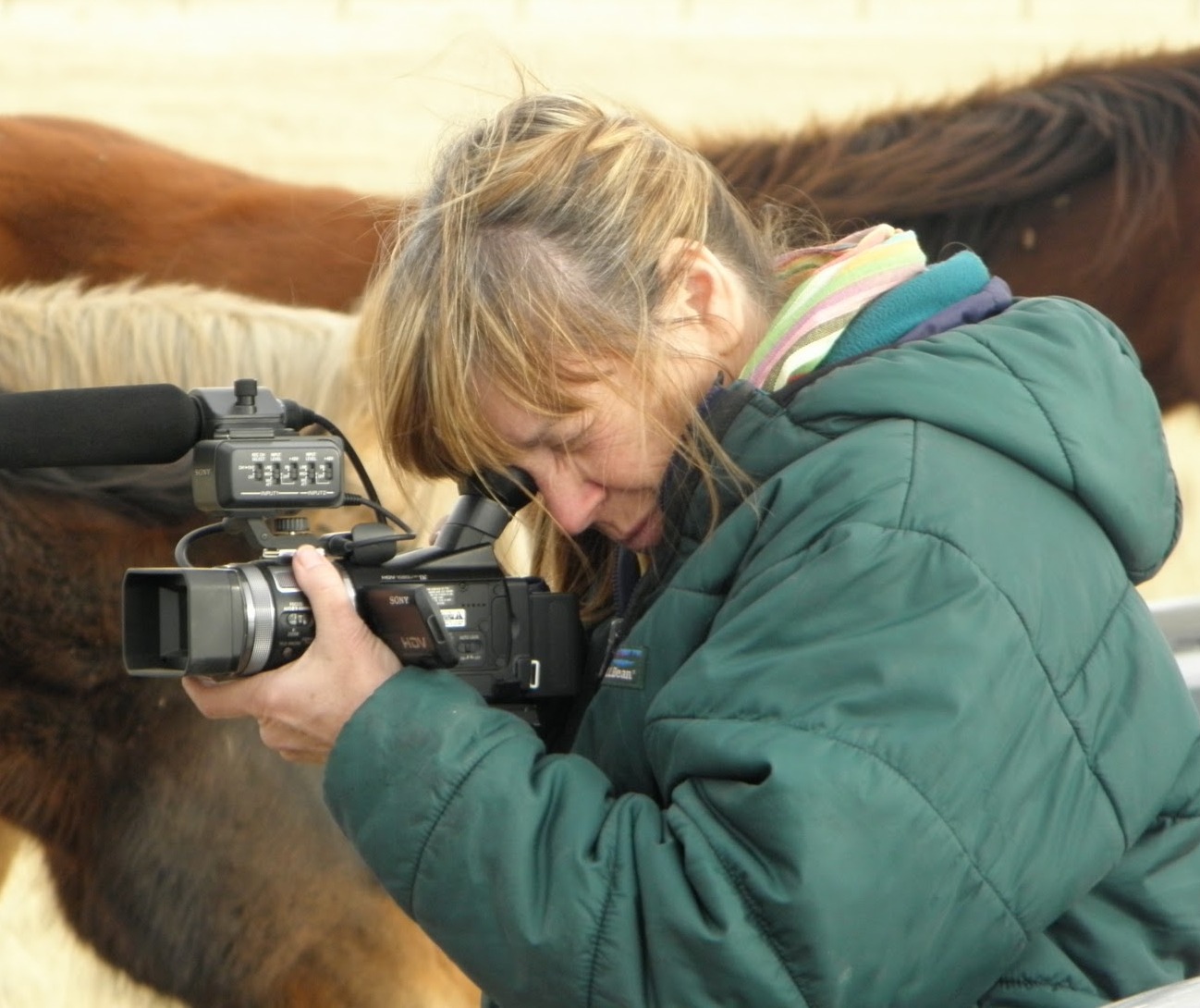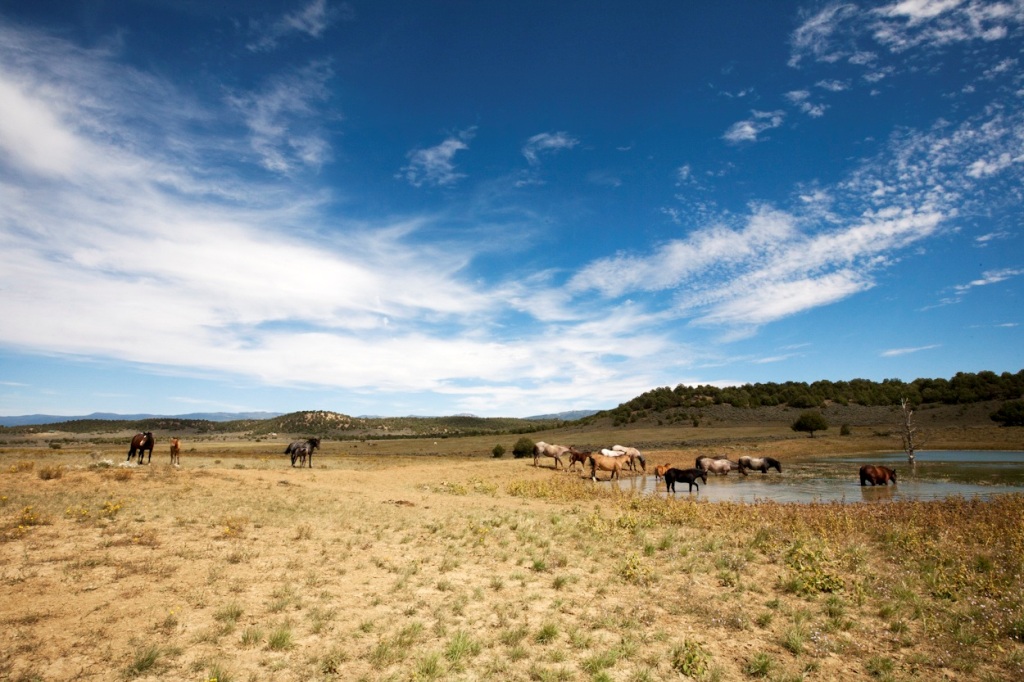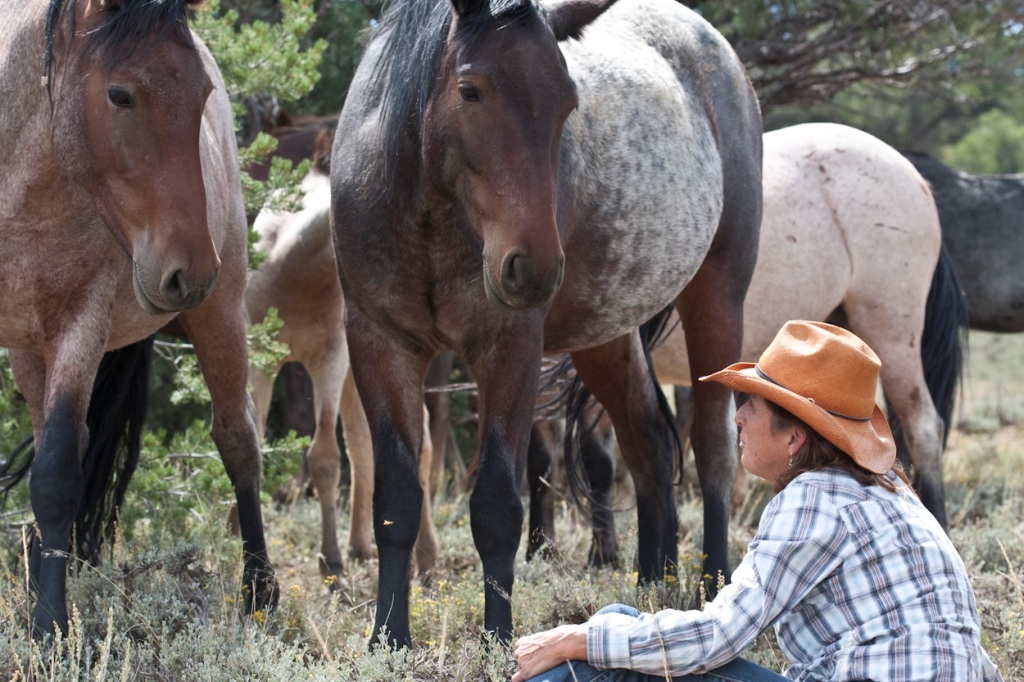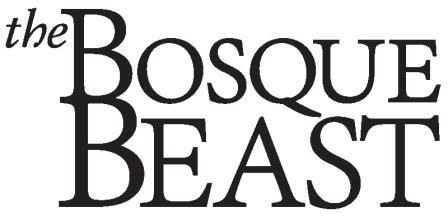
A Santa Fe filmmaker delves into
a little-understood connection
Donna Wells’ new documentary offers far more than the usual winking allusion to budding hormones. Motivated largely by her long friendship with Corrales horse photographer Lynne Pomeranz, Wells explores themes rarely considered in relation to horses, through interviews with women whose lives were transformed by them, in many cases by wild mustangs.
Far from romanticizing the horse’s physique or nobility, these women talk more about the emotional and existential life of horses, especially in their free and natural state. “Most people aren’t tolerant of a horse that says ‘I don’t want to be touched’” says Jackie Fleming, founder of a horse sanctuary near Cerrillos, at the start of the 48-minute film.
But “I really love it when it’s their choice to come up and let me touch them,” she says of the rescued horses at her Cimarron Sky-Dog Sanctuary. “It’s how I want to be around them.” Thus begins what turns out to be a rarely considered, feminine view of the horse: a relationship born of respect and nurtured with equality, which turns on its head the common assumption that horses exist to be used.
Wells and Pomeranz had been planning to make a film about wild horses since they met two decades ago at the Anthropology Film Center, an ethnographic film school formerly in Santa Fe. Wells eventually got into land conservation; Pomeranz turned to still photography and became an award-winning horse photographer and wild horse advocate. Three years ago, Wells rediscovered the camera, went back to film school, and found a topic of inspiration when she had her horse treated by equine therapist Shelly Gibb.
“Watching her work, and knowing about Lynne’s advocacy and the sensitivity of her photographs, I realized that most of the people I work with (on horses) are women,” she explains. “Because women in our patriarchal society have had to develop their sensitivity, I thought it would be a good topic for a film.”
Shot in the stunning rangeland around Cerrillos and Chama, She Had Some Horses (the title is from a poem by Joy Harjo) interviews the founders of two wild horse sanctuaries, an equine bodywork therapist, and three photographers, one of them an 8-year-old girl.
American mythology is crowded with horses, from the Wild West to the Kentucky Derby — and yet the reality of how horses are treated in the West ends up pushing all the women in the film to political activism. But this is not the usual hot indignation of contemporary politics, or the gruesome shock tactics of exposing animal abuse. The passion of these wild horse advocates comes across as something closer to love than hate, motivated more by grief than anger.

“To come to where they live and be in their world, you really understand,” says Raquel Waller, on one of Pomeranz’s photography workshops in the Jicarilla Wild Horse Territory near Bloomfield. “There’s a primal feeling we all have — laying our heads on the pillow at night and knowing that wild horses still run free is kind of essential for our sanity.”
“It’s a quiet little voice somewhere,” Waller continues, “and my fear is that my child will grow up and never have that whole picture, and never feel it as I feel it.” Her daughter, 8-year-old Cheyenne Rondeau, had raised $3,000 for wild horses by the end of the film.
New Mexico nearly became the first state to designate a wild horse sanctuary — a triumph celebrated in the film with a 2010 press conference by former Gov. Bill Richardson — but the epilogue tells us the sanctuary was never funded. (Current Gov. Susana Martinez was among the leading opponents.) Wild horses continue to be rounded up by the BLM for sale or slaughter; the women continue to pay for their intimate understanding of horses with grief.
“Horses are so sensitive, they remind us to be authentic, and that it’s OK to be who we really are inside,” says equine bodyworker Gibbs, who learned through working with her damaged horse how to cope with her own sensitivity. “They have allowed me to become more of a whole person through interacting with them. “I would urge anybody who has a chance to interact with horses to find a way to do that,” she adds. “Just to see them together in a pasture would move people to understand something different about themselves inside.”
It is a hope the filmmaker clearly shares, raising awareness not by enraging people but by “focusing on the positive — because there’s already plenty of places to read the horror stories.” Wells believes it must be possible to move people without horrifying them.
She credits her work with Argentine director Luis Puenzo (The Official Story, Old Gringo) for stirring her interest in film and in New Mexico; as an actress and film crew worker in Los Angeles, she was touched by his ensemble directing style, a cooperative approach that might be considered more typically feminine.
Indeed, while Wells’ film speaks most to women who love horses, it is also about the growing importance of female sensibility to a world in crisis. The point is brought home by long segments with Waller and her daughter Cheyenne. “We’re destroying all that is good,” the photographer says. “Once we do that, what do we have? We have nothing.”
A society that no longer values wild horses because they are of little “use” similarly disregards the place of passion, emotion, empathy, and kindness. “In our society, it’s not easy to be that way,” Gibbs says of being sensitive. “There’s not a lot of support.”
Horses’ natural readiness to respond to human emotion serves to heal people cut off from their own wildness, the women say. It just requires that you open yourself to relating to these magnificent creatures in a different way.
“I try to give people a glimpse into their real spirit, their individual personalities,” Pomeranz says of her iconic wild horse portraits, “so that they can really feel them as individuals, and understand what’s at a loss as they take them away.”
She Had Some Horses will be screened September 7 at Legends Gallery in Santa Fe in a benefit for the Cimarron Sky-Dog Sanctuary. A portion of all gallery sales during the month of September will go to the sanctuary. The film will also be shown at the White Sands International Film Festival, Aug. 22-26 in Las Cruces (www.wsiff.com).

A place where
wild horses still run free
Sandi Claypool leases 4,700 acres of rich pastureland near Tierra Amarilla, on the road to El Vado Lake, south of Chama. On the dirt road up to her homestead, goats are seen making an experimental jail break out of their pen, for which they get yelled at. Claypool drives a beat-up truck with a cracked windshield, and she lives in a vintage trailer – her home for the last four winters. The 4,700 acres is not a recluse’s kingdom, in other words, but just enough land to care for some 115 horses, many of them born wild and never broken.
Claypool founded the Monero Mustang Sanctuary with her late mother, Ila Bromberg, in 2003 after they adopted a stallion rounded up by the Forest Service on the Jarita Mesa Wild Horse Territory. Initially the idea was to breed genetically pure mustangs, as the women feared that the horse that figured so prominently in the history of the West would soon be bred out of existence. The Jarita territory, in the Carson National Forest outside El Rito, is one of the few remaining public lands where horses run wild. What the Forest Service deems “excess” animals are auctioned off individually, diminishing their bloodlines.
After Bromberg died in 2010, Claypool continued to care for the horses on her own. Disputes with the state Livestock Board have put her breeding project on hold, not least because the state veterinarian has barred her from using birth control on the horses. Her main goal now, she says, is to give them a place to live free and safe.
Bumping down the narrow trails that snake across undulating fields, one comes across small bands of horses gathered at watering holes, in the shade, and grazing out in the open, all of whom Claypool recognizes by name and bloodline. She knows their children, their partners, their dramas. Most mustangs have lived at the sanctuary long enough that the sound of an engine no longer sends them fleeing. Claypool doesn’t try to approach them, but will sit or lie on the ground and wait for the horses’ natural curiosity to bring them nodding over.
Besides caring for the horses and land, Claypool struggles to keep her nonprofit operation afloat. Most of her resources come from half-day tours she leads to visit the horses, which are popular with artists and photographers, as few places remain where wild mustangs can be observed up close.
To arrange a tour, contact Sandi Claypool to reserve at sandi@moneromustangs.org or call 575.756.8674. The cost is $100 per person. Individual mustangs can be sponsored for $250 a year, tour included. All proceeds go to support the horses. Donations of feed and veterinary care are also welcome: www.moneromustangs.org
